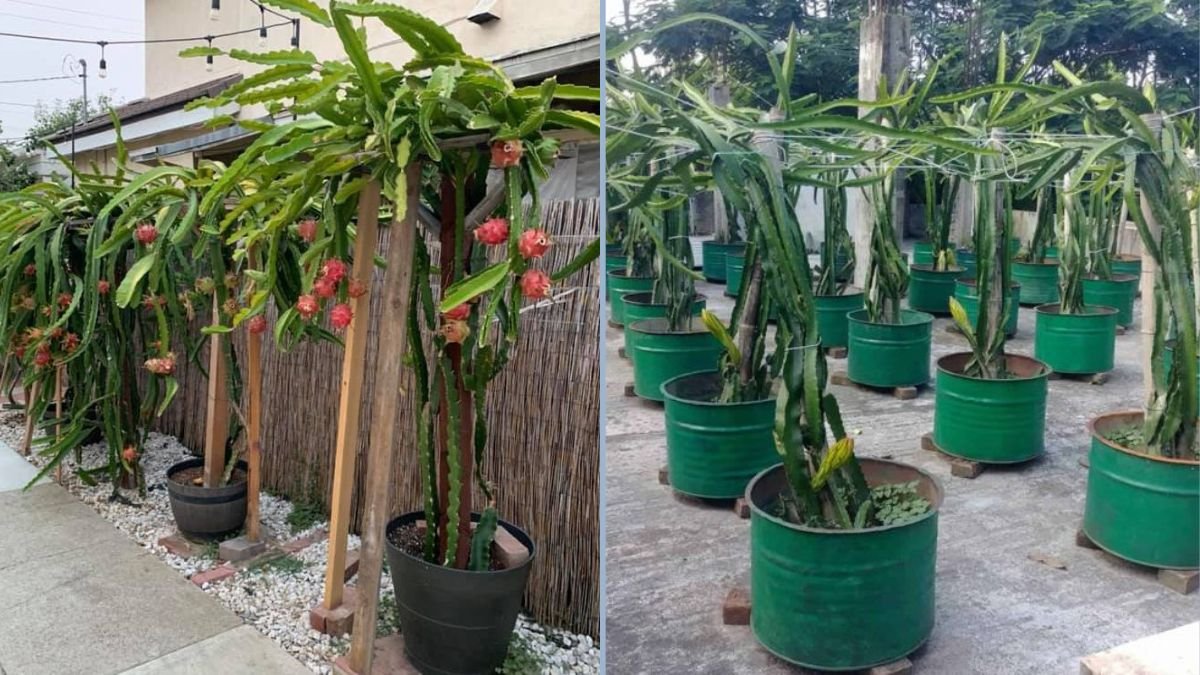Dragon fruit, also known as pitaya, is a tropical cactus that has gained popularity for its vibrant appearance, sweet flavor, and numerous health benefits. While it naturally grows in tropical regions, the good news is that dragon fruits can be successfully cultivated in containers, making it accessible to urban gardeners and those with limited space.
In this comprehensive guide, we’ll take you through the entire process of growing dragon fruits in containers — from selecting stems to harvesting your own juicy fruits.
1. Why Grow Dragon Fruits in Containers?
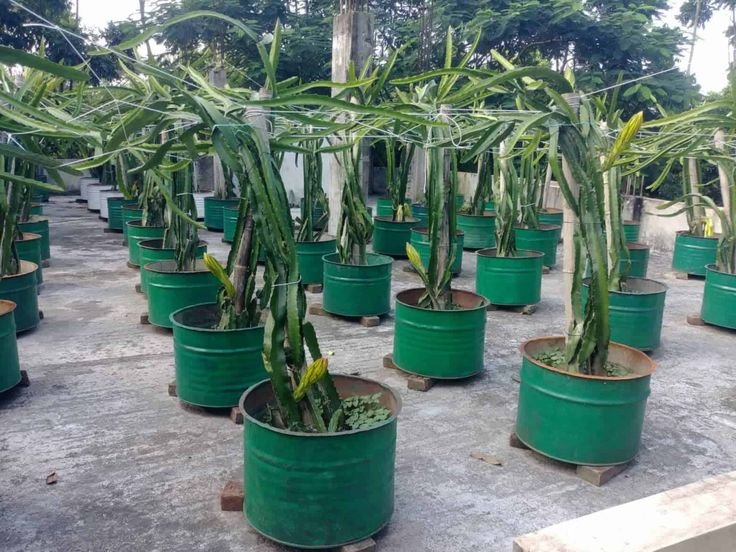
Container cultivation has several advantages for dragon fruit plants:
- Space-efficient: Ideal for terraces, balconies, and patios.
- Soil control: You can provide well-draining, nutrient-rich soil tailored to cactus needs.
- Mobility: Move containers to maximize sunlight or protect from harsh weather.
- Pest management: Easier to monitor and control pests.
- Aesthetic appeal: Dragon fruits have striking flowers and vibrant fruits that enhance home gardens.
With container cultivation, even urban gardeners can enjoy fresh, homegrown dragon fruits.
2. Choosing the Right Dragon Fruit Stem
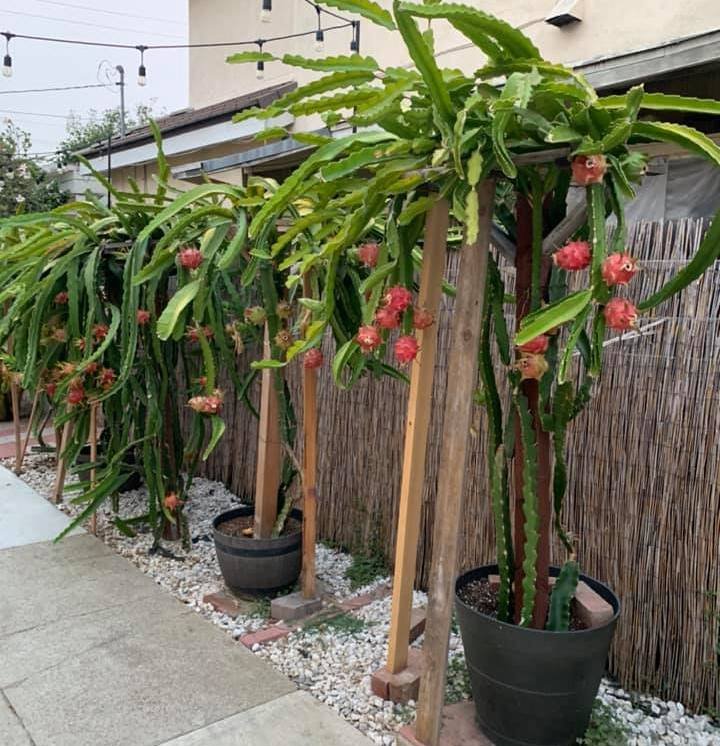
Dragon fruit plants are propagated from stems rather than seeds for faster growth and earlier fruiting.
Selecting a healthy stem:
- Look for thick, firm, and green stems free from disease or pests.
- Avoid stems with yellowing or soft spots.
- A 12–18 inch segment is ideal for planting.
Proper stem selection ensures higher survival rates and strong initial growth.
3. Preparing the Stem for Planting
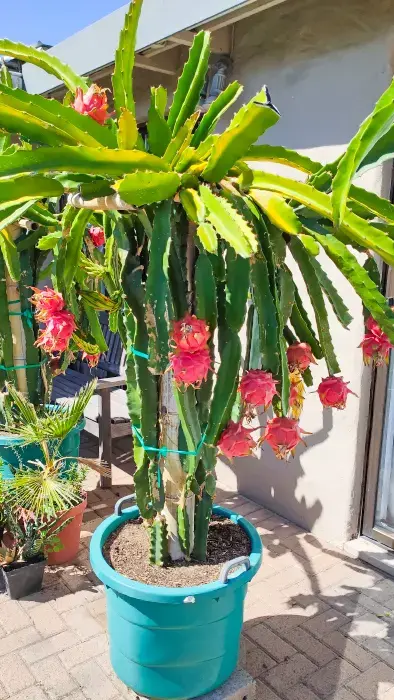
Before planting, the stem needs preparation:
- Let the stem dry for 2–3 days to allow the cut end to callus. This reduces the risk of rot.
- Trim any damaged edges with clean scissors.
- Optionally, dip the base in rooting hormone to encourage faster root development.
A well-prepared stem improves rooting success and plant health.
4. Choosing the Right Container
The container is critical for dragon fruit growth:
- Size: Minimum 18–24 inches deep and wide for a single stem.
- Material: Plastic or terracotta pots are ideal. Terracotta allows better aeration but dries faster.
- Drainage: Multiple drainage holes prevent waterlogging.
- Mobility: Use a pot that can be moved to optimize sunlight exposure.
A suitable container ensures healthy roots and robust growth.
5. Preparing the Soil Mix
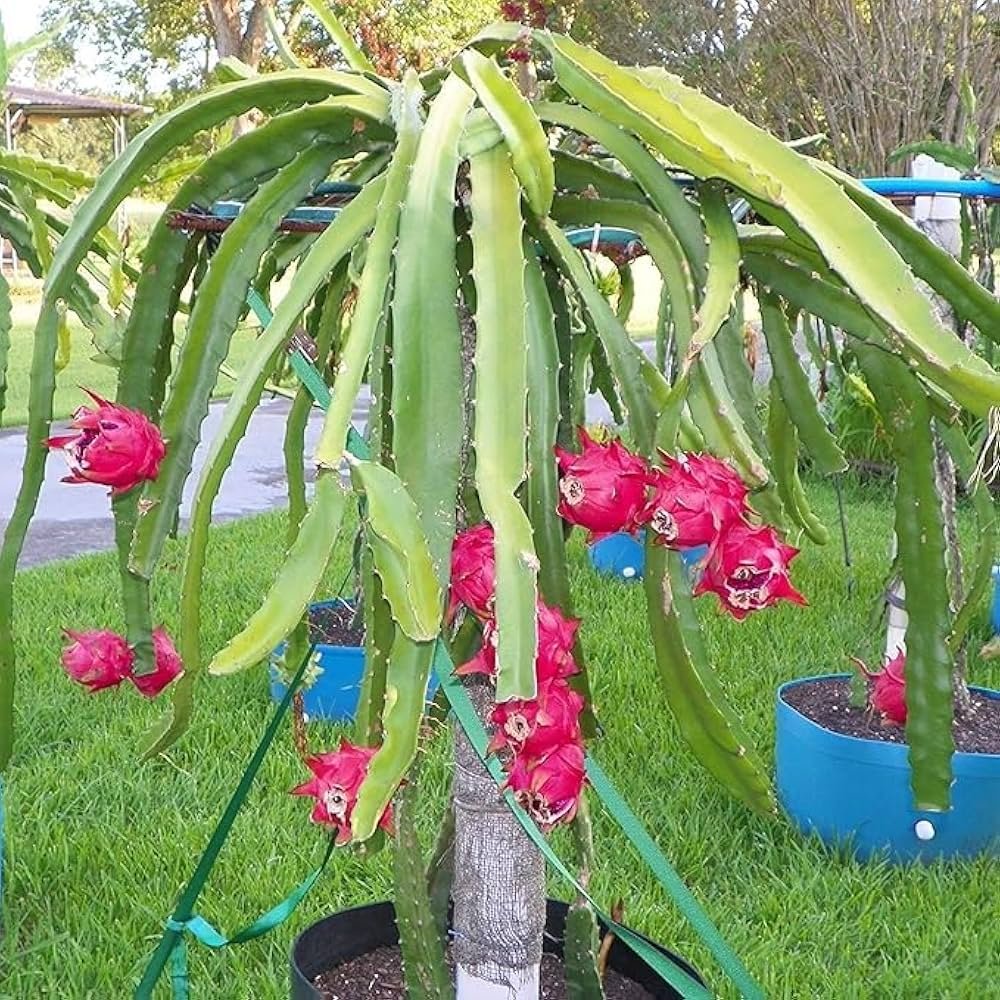
Dragon fruits are cacti, so they require well-draining soil. A good soil mix prevents root rot and supports nutrient uptake.
Recommended soil mix:
- 50% cactus potting mix or garden soil
- 30% perlite or coarse sand for aeration
- 20% organic compost for nutrients
💡 Tip: Avoid heavy clay soils as they retain too much water, which can harm the roots.
6. Planting the Stem in the Container
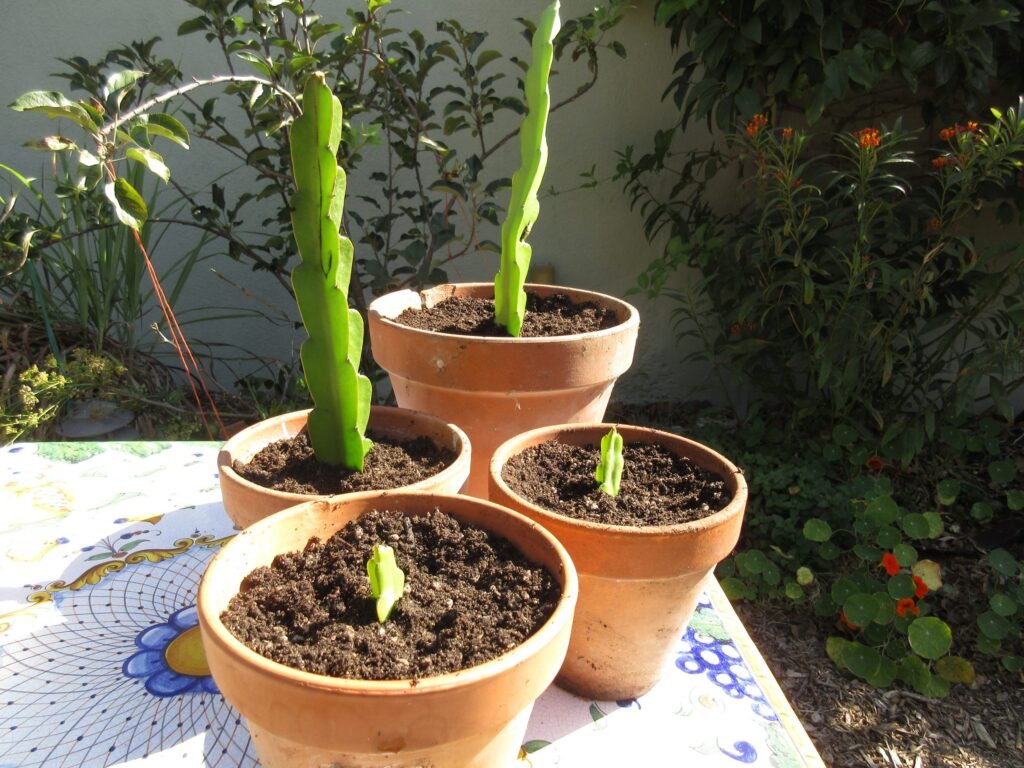
Follow these steps for successful planting:
- Fill the container partially with the prepared soil mix.
- Insert the callused stem about 2–3 inches deep into the soil.
- Firm the soil gently around the stem.
- Support the stem with a stake or trellis for vertical growth.
- Water lightly to settle the soil.
Proper planting ensures stable support and encourages root establishment.
7. Sunlight and Temperature Requirements
Dragon fruits thrive in bright sunlight and warm temperatures:
- Sunlight: 6–8 hours of direct sunlight daily. Gradually introduce young plants to full sun.
- Temperature: Ideal range is 20–35°C (68–95°F). Protect from frost and extreme cold.
- Air circulation: Adequate airflow reduces fungal infections and promotes healthy growth.
Providing the right environment ensures strong stems, lush growth, and abundant flowering.
8. Watering Dragon Fruit Plants
Watering is crucial for container-grown dragon fruits:
- Keep soil moist but not waterlogged.
- Water deeply 2–3 times per week, adjusting for rainfall and temperature.
- Reduce watering in winter when the plant enters a dormant phase.
- Mulching helps retain moisture and protect roots.
Proper watering promotes strong roots and healthy fruit development.
9. Fertilizing Dragon Fruits
Fertilization supports growth, flowering, and fruiting:
- Use a balanced fertilizer (NPK 10:10:10) during vegetative growth.
- Apply a phosphorus- and potassium-rich fertilizer during flowering to promote fruit set.
- Fertilize every 4–6 weeks during the growing season.
💡 Tip: Avoid over-fertilization with nitrogen, which encourages excessive leafy growth at the expense of flowering and fruiting.
10. Supporting Your Dragon Fruit Plant
Dragon fruits are climbing cacti, so they require support for vertical growth:
- Use a trellis, stake, or pillar for the plant to climb.
- Tie the stem gently with soft ties to prevent damage.
- Train lateral branches along the support to maximize flowering space.
Proper support ensures healthy growth, strong stems, and easier fruit harvesting.
11. Pruning and Training Dragon Fruits
Pruning improves plant health and fruit production:
- Remove weak, damaged, or overcrowded stems.
- Trim lateral branches to allow sunlight penetration.
- Prune after fruiting to encourage new growth.
Regular pruning leads to more flowers, larger fruits, and reduced disease risk.
12. Flowering and Pollination
Dragon fruit plants produce beautiful nocturnal flowers that bloom for a single night:
- Most varieties are self-pollinating, but cross-pollination improves fruit size.
- Bees and other insects aid in natural pollination.
- Hand pollination with a small brush is possible for indoor or balcony plants.
Effective pollination ensures higher fruit set and sweeter fruits.
13. Harvesting Dragon Fruits
Patience is key — dragon fruits usually mature 30–50 days after flowering:
- Fruits are ripe when the skin color changes (red or pink, depending on the variety) and are slightly soft.
- Twist or cut the fruit gently from the stem to avoid damage.
- Frequent harvesting encourages continued flowering and fruiting.
Homegrown dragon fruits are sweet, juicy, and packed with nutrients.
14. Common Pests and Diseases
Container-grown dragon fruits are relatively hardy but may face issues:
- Aphids and mealybugs: Spray neem oil or insecticidal soap.
- Fungal infections: Ensure proper airflow and avoid waterlogging.
- Stem rot: Prevent by using well-draining soil and not overwatering.
Regular monitoring ensures healthy growth and high-quality fruit.
15. Long-Term Care of Container Dragon Fruits
To ensure long-term success:
- Repot into a larger container every 2–3 years to accommodate growth.
- Mulch regularly to retain soil moisture.
- Fertilize seasonally to maintain nutrient levels.
- Provide sturdy support and prune annually to manage growth.
With consistent care, your dragon fruit plant can produce fruit for many years, even in a container.
16. Final Thoughts: Growing Dragon Fruits at Home
Growing dragon fruits in containers is rewarding, practical, and fun. With proper care — including selecting a healthy stem, preparing soil, providing support, watering, fertilizing, and pruning — you can enjoy homegrown, exotic fruits even in limited spaces.
Container gardening allows urban gardeners to create a mini dragon fruit orchard on balconies, terraces, or patios. With patience and attention, your plant will flourish, producing beautiful flowers and delicious fruits year after year.
Growing dragon fruits in containers brings exotic fruits and tropical beauty to your home garden. By following this step-by-step guide, beginners and experienced gardeners alike can enjoy the full journey from stem to harvest, reaping the rewards of fresh, sweet dragon fruits.
